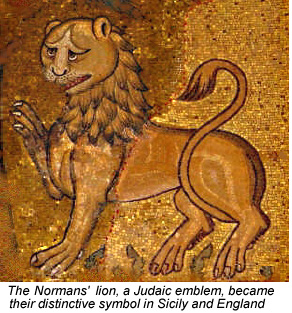...Best of Sicily presents... Best of Sicily Magazine. ... Dedicated to Sicilian art, culture, history, people, places and all things Sicilian. |
by Luigi Mendola | |||
Magazine Index Best of Sicily Arts & Culture Fashion Food & Wine History & Society About Us Travel Faqs Contact Map of Sicily
|
Thus began Sicily's multicultural Golden Age under a series of inspired monarchs descended from the Hautevilles, an era culminating with the death of the remarkable Frederick II, Roger's great grandson, in 1250. Until then, and indeed for a few years afterward, the Kingdom "of Sicily" encompassed most of the Italian peninsula south of Rome. Only after the War of the Vespers (in 1282) did Naples emerge as a royal capital with its own sovereign. The fact that both Charles of Anjou (in Naples) and his rival Peter of Aragon (in Palermo) claimed the Sicilian crown contemporaneously led to the phrase the Two Sicilies. Over time, owing partly to dynastic inheritance, the twin realms - insular Sicily and peninsular Naples - were occasionally ruled by the same monarch, at once King of Naples and King of Sicily (and sometimes, as it happened, also King of Spain or Holy Roman Emperor). Only in 1816 were the two nations formally united, or reunited, to form the state known as the Kingdom of the Two Sicilies. In 1861 this kingdom, then the most prosperous of the Italian states, was annexed to the new Kingdom of Italy. Salic Law, and with it the principle of succession through male primogeniture, prevailed, but there were actually several queens of Sicily who, whether as regents during a son's minority or during a complicated interregnum, effectively ruled Sicily in their own right. Three that come to mind are Margaret of Navarre, widow of William I and mother of William II, from 1166, Constance, daughter of Roger II and mother of Frederick II, briefly from the death of her husband Henry VI in 1197, and young Mary of Aragon following the death of her father in 1377. The Normans and Swabians brought feudalism and other European ideas to Sicily, in the process gradually latinizing the language and church while introducing such things as heraldry, thus integrating the island into the Latin, Papal "West," whereas for six centuries it had found itself in the Byzantine and Arab worlds. In the list that follows, we've omitted pretenders. For example, under Papal auspices, Edmund "Crouchback" Plantagenet, son of Henry III of England, claimed the Sicilian crown from 1254 to 1263, but only from a distance. Until the eighteenth century, there was a strong hereditary basis for the legitimacy of most Kings of Sicily - Charles of Anjou's Papal appointment being the exception - even where this was tenuous. In particular, Constance, the wife of Peter of Aragon, was the daughter and universal heir of Manfred Hohenstaufen, an illegitimate but recognised son of Frederick II, so when her own son, James, became king of Sicily in 1285, he could rightly claim to have restored at least a few drops of Hohenstaufen blood to the Sicilian throne. Kingship in Sicily was not much different from what existed elsewhere in Western Europe. Until 1392 their official residence was Palermo's Norman Palace; for a few centuries thereafter it was Steri Castle, which eventually became the viceroys' residence. It was during the fifteenth century that the viceroys arrived, and henceforth Sicily's kings - who were also monarchs in Spain or elsewhere - rarely set foot on the island, though the arrival of the Bourbons in 1734 improved matters somewhat. Sicily has been much contested over time, a fact reflected in the diversity of the dynasties who conquered the island kingdom. What shred of Sicilian sovereignty survived into the nineteenth century ended with the controversial Risorgimento movement and the annexation of the Kingdom of the Two Sicilies to the new Kingdom of Italy in 1861. Here the reign of each sovereign is indicated. Numeration is based on reigns as Kings of Sicily, so Emperor Frederick II is listed as King Frederick I of Sicily, while Emperor Charles V is King Charles II of Sicily. See our timeline for specific events. House of Hauteville (Norman) 1130-1194 House of Hohenstaufen (Swabian) 1194-1266 House of Anjou (French) 1266-1282 House of Aragon (of Barcelona) 1282-1409 House of Trastámara (of Castile) 1410-1516 House of Hapsburg (Spain) 1516-1713 House of Bourbon (Spain) 1700-1713 House of Savoy (Piedmont) 1713-1720 House of Hapsburg (Austria) 1720-1734 House of Bourbon (Two Sicilies) 1734-1816
About the Author: Historian Luigi Mendola has written for various publications, including this one. | ||
Top of Page |
 At the dawn of the Middle Ages,
in the waning years of the Western Roman Empire, following a brief occupation
by
At the dawn of the Middle Ages,
in the waning years of the Western Roman Empire, following a brief occupation
by